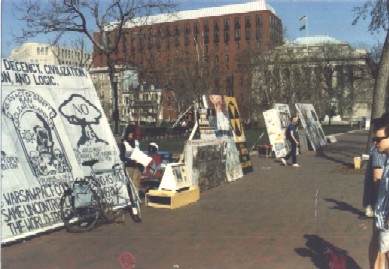
"Lafayette Square 'Swept' Clean
By Kenneth Bredemeier
Washington Post Staff Writer
May 10, 1985
The team of 15 gray-shirted National Park Service maintenance workers arrived shortly before 2 p.m. yesterday at the Lafayette Square sidewalk office of Casimer Urban Jr., self - styled presidential candidate.
Within half an hour, the workers had carted off many of his books and personal papers and hauled away his office, a triangular 10-foot-high plywood structure he had erected and covered with crudely painted messages calling for the impeachment of "R.W. Reagon." They left his two desks and assorted other office equipment.
A short distance away, a small contingent of' U.S. Park Police yanked long- time anti-nuclear demonstrator Ellen
Thomas off a portable stage as she screamed at them and arrested her and a man who tried to assist her. Workers promptly hoisted the stage onto a truck and took it away, too.
At Lafayette Square, directly across Pennsylvania Avenue from the White House, such scenes are commonplace these days.
The park has become a battleground between the conflicting demands of court decisions supporting the First Amendment right to demonstrate, albeit with a raft of rules, and those who think the clutter of hand-oainted signs and rickety structures built by the demonstraters has turned the park into an eyesore.
Sen. Mark Hatfield (R-Ore.) complained to the Park Service earlier this year about the "growing visual pollution around Lafayette Park," which he called "highly offensive."
U.S. Attorlley Joseph E. diGenova, echoing the feelings of some, but not all, visitors to the park, said, "While some of these people think they're making a statement, in fact they're making a mess. At this point, it's beconling a disgrace .... We're going to do whatever we can within the law to keep the park clean."
Interior Department officials have ordered police and maintenance workers into Lafayette Square five times in the last three weeks to look for signs that don't comply with Park Service regulations, as well as loose lumber and piles of clothing and personal belongings that demonstrators are prohibited from keeping in the park.
But, just as soon as the workers have carted off truckloads of signs and possessions, they reappear.
This cat-and-mouse game, which is not likely to be resolved soon, had its origin in two court decisions last year.
In one Instance, the U.S. Court of Appeals here approved a series of Interior Department regulations on protests on the sidewalk in front of the White House that limited the size of signs to 3 feet by 20 feet, prohibited all stationary signs in a
central zone and banned wooden signs.
As a result, most protesters, many of them demonstrating
against Reagan administration nuclear arms policies, have now
moved to Lafayitte Square, where there are no size limits on the signs and they can be built wlth wood. Some signs are now--20 or 25 feet tall, such as one saying, "We believe no issue is more important than the threat of nuclear war."
In the second decision, the Supreme Court last year banned over-night sleeping in Lafayette Square as a means of protest, saying it was not a First Amendment right.
That decision has led to almost constant conflict between the Park Police and the small band of 24- hour-a-day demonstrator s, who trade off guarding each others' signs through the night. Until earlier this week, most of them, as well as two dozen or more homeless people, had been sleeping on the steps and entrance arcade of the National Court Building, across Madison Place from the park.
But Federal Protective Service officers at the urging of court officials, this week booted out the sleepers, who now have opted for spending the night on the sidewalk.
Arthur B. Spitzer, the legal director for the local division of the American Civil Liberties Union, has fought government restrictions on protests in the vicinity of the White House. He said he is monitoring the latest Lafayette Square sweeps by
police and maintenance workers.
"The First Amendment protects your right to have a fairly big sign," he said. "But there's some things; there I couldn't defend, such as large piles of personal belongings. I have no objection to the government hauling away things that are not
communicative .... "The protesters can't homestead there."
Royce C. Lamberth, head of the civil division in diGenova's office, said officials are studying ways "to improve the situation in Lafayette Park" and may try to devise further rules on the demonstrations, such as limiting the size of signs.
Meanwhile, many of the long term demonstratots vow to kecp their vigils.
Conception Picciotto, a 43-year-old native of Spain, said she has maintained her anti-nuclear protest on Pennsylvania Avenue for four years, and said she will continue "as long as God gives me health ard strength.
"The Constitution allows us to present our views peacefully," she said as she handed out literature this week. "We are not going to give up."
Concepcion Information List | Conchita Personal Story
Photographs | The President's Neighbor